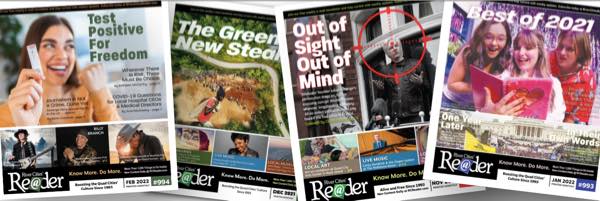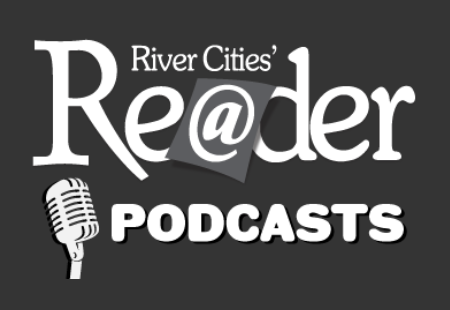"We want your feedback," she told artists later. "We want your participation."
But if the Figge is to become a vital place for creative types and not just patrons when it opens in 2005, Davenport Museum of Art (DMA) officials are going to need to adjust their plans to include activities involving more local artists.
The premise of the gathering at the DMA was to generate ideas on "how artists can be more involved with the Figge," Downs said. Approximately 50 people attended the gathering, and they divided into three discussion groups: education, art-making, and exhibits and displays.
The largest group was exhibits, and it focused on showing local artists and getting them more involved in the exhibits the museum chooses to bring in or curate.
Artists were adamant that current plans for showing local and regional art were inadequate.
When asked about how much gallery space and time will be dedicated to local and regional art at the Figge Arts Center, DMA Curator Michelle Robinson said, "There is a gallery that will be shared with the print collection," and it will feature regional art at least once a year. One artist in attendance responded with one word: "Stinks."
Artist Pete Schulte immediately suggested "local and regional shows more than once a year" as an idea for the Figge Arts Center.
One person said that one show a year won't give artists the feeling that they're wanted at the museum. "If you're only delegated to once a year, it's not much, 'Welcome.' It's the old concept, and that isn't the way it should be."
And at the meeting's opening, Downs also suggested a different vision than the one Robinson articulated. She said there will be "a continual presence of regional artists at the Figge," and that the center would be "the premier place for regional artists to exhibit."
"If I went to a show in Paris, I'd expect to see Parisian artists," one attendee said. The lack of local art at the Figge Arts Center would suggest to museum visitors that "we're a second-tier city."
One popular idea was to dedicate some gallery space to local and regional artists, for instance, having monthly exhibitions of locally created art.
The clock is ticking for some of these decisions, though. Downs said there's a May 1 deadline for establishing how all the Figge's space will be used.
Judi Holdorf, executive director of Quad City Arts, suggested that the Figge Arts Center should be "a premier exhibition place for regional and local artists." In that scenario, the Quad Cities would essentially have a tiered exhibition system, with the Figge being the pinnacle, displaying the best the area has to offer. Exhibit spaces run by Quad City Arts and MidCoast Fine Arts would be stepping stones.
Yet that idea also had its critics. "I don't think we should duplicate what Quad City Arts or MidCoast is doing," one person said. "We should do shows they can't."
That comment showed a certain division in the group. While many thought the Figge should be a showcase for local artists, others thought that would be straying too much into promotion. Several people at the meeting thought the Figge should instead be an artistic repository focusing on education.
Beyond stand-alone exhibits featuring local artists, the group came up with other ideas. The people at the meeting seemed interested in the Figge Arts Center curating more of its own exhibits, and at the least considering local artists for inclusion in themed shows.
If the Figge chooses to feature local artists in a companion show to a touring exhibition, several people said, the local artists need to be featured more prominently. With the Defining Craft exhibit last year, the works of local artists were "made very secondary," one person said.
Other suggestions included:
· Having artists comment on works in the permanent collection, either visually or verbally.
· Having the Figge curate shows in the community but outside of the arts center (thus expanding is presence).
· Diversifying exhibitions, including newer and more cutting-edge work.
· Adding regional and local art to the museum's permanent collection.
· Hosting panel discussions with local artists talking about exhibits.
· Having a working studio related to exhibits.
· Bringing in artists-in-residence.
The creation of an artist advisory board is one step that the DMA plans to implement quickly. Downs said she'd like to have such a body in place by July 1. The idea was part of the DMA's plans in the past but was never implemented.
While the forum focused on ideas for the involvement of local artists in specific areas, there was also some discussion of the Davenport Museum of Art in general. Some artists claim that overall, the DMA has not communicated with artists, and that has to change for the Figge Arts Center to be a more alive institution. "The museum has to create a dialogue that hasn't existed," Schulte said.
There is a chicken-and-egg quandary here. Critics say the DMA does not have a track record of outreach to the community's adult local artists. Yet programmatic efforts including lectures and workshops by nationally known artists have gone largely unattended by the local creative community. It's almost as if the museum staff and local artists are in a standoff.
Last week's open forum was certainly a step in the right direction. And an artist advisory board has the potential to lend much-needed creative energy to the Figge Arts Center.
But creating the dialogue Schulte referred to might still be a challenge, as evidenced by a minor exchange at the forum. One person asked how he and other artists could find out about upcoming exhibitions. Robinson told him the information was available in a brochure and on the museum's Web site, but no effort was made to put him on the mailing list or get him a brochure.










